Blood Wedding: Following Lorca to the Cortijo del Fraile
Woken in the early hours by sounds of pig-like snuffling (that did not come from the other side of the bed) I poked my head around the door of of our room and shone a torch into the dry river bed below. From beneath the protecting hedge of prickly pear, a startled group of eyes reflected back at me. A family of wild boar straying from the wilderness of the sierra were investigating the spoils of human life at the edge of the village. Returning to bed, I woke again at dawn, slipping across the gardens for a swim in the pool, surrounded by flowers and awakening insects as the sun rose, not another soul about.
Breakfast was served on the terrace, a single table for us, the only two guests, set precisely with napkins and coffee cups, a menu in English providing a choice of granola, yoghurt, fruit, ham and cheese. We opted for our usual and a large plate of two different hams, four cheeses, yoghurt and plenty of black coffee in a large pot was placed before us. Fresh orange juice, Eckhard assured us, was ‘automatic’. The basket of accompanying bread revealed a little Germanic touch, hidden amongst the more usual Spanish pan, a couple of slices of dark pumpernickel provided a strangely exotic contrast.
With a generous layer of sun lotion (Factor 50, there is very limited shade) and straw hats on, we set off, stopping off in Rodalquilar to stock up on water and a few snacks for the day. Eckhard had recommended one of the three small shops in the village so we aimed for that. Inside, it was tiny, and crammed full of carefully curated stock, definitely a foodie’s paradise. A tall darkly tanned blonde woman beckoned me into the second packed room to look around, her accent German, another settler from the northern climate. On the wooden counter rested a large glass dome protecting a homemade orange and almond cake, too moist and crumbly to resist. A bag of roasted marcona almonds was added to a thick wedge of cake wrapped in brown paper, with a couple of litres of Lanjarón water we were set to go. ‘I hope you have plenty of sun block’ said the German shop keeper, obviously noticing our pale sun-deprived English complexions. The day was going to be hot.
We walked up the street following the directions for the Ruta de la Minería (route of the miners), the sun’s heat already fierce. On our left, we passed a street of derelict houses, old miner's accommodation, now mostly sun bleached and irreparable. Just further along, the Tourist Information Centre delayed us with a charming free exhibition of paintings of local fish. We dawdled a little, somewhat taken back by the heat and I began to doubt whether it would be wise to start the long route in the unrelenting sun.
Discovering the botanical gardens of Albardinal just around the corner, we headed for the welcome shade of the courtyard, venturing further inside before looking out over the surprising large gardens, full of interesting plants and flowers. It was deserted, no one appeared and I wasn’t even sure if we needed to pay an entrance fee. We wandered about, noting the names of plants we had seen on our walks that had evaded identification and marveled at the size of some that are only seen as tiny houseplants in the UK. There was even a lichen garden, large rocks held aloft on a series of pillars, covered with a graffiti of brightly coloured primitive plants.
Deciding to brave the heat and keep to plan, we slipped unnoticed back out into the sunshine, walking up the hill, past the the church and down the side of an industrial building onto the Sendero Cerro de Cinto, a rough track following the outskirts of the remains of the gold mine. Rodalquilar was first mined for lead and silver before gold was discovered in the late 1800s. However, mining this precious metal was exceptionally difficult and it wasn’t until 1931 that a British company found a way to successfully extract it. The Spanish Civil War ended their work in 1936 and a few years later the mines returned to the Spanish state in 1943. A briefly prosperous period in the 50s and 60s followed before the mines were finally closed in 1966. Mining the tiny amounts of gold was very inefficient and dangerously destructive using mercury and cyanide to extract the gold sediment from the rocks. Along one side of the track and stretching out down the slopes, distinctive mounds of earth and stones have been put in place to prevent the mercury contaminated mud escaping the into the valley below.
Leaving behind the industrial remains, the track continued gently uphill past ancient terraces of rocky soil and endless views across the volcanic crater of the Rodalquilar valley. Following the course of yet another dry river bed we walked higher and higher up into the sierra until it felt like we where miles from anywhere, crickets jumping from our path and the occasional shadow of the sweeping wingspan of an eagle swooping down to inspect the strangers below.
With the track now ascending steeply along rocky steps, the effort of walking in the midday sun became much harder and we stopped frequently to take a breather, sharing a bottle of water. At a tiny rocky cave someone had set up a small pile of stones to indicate the way and with a final breathless effort we reached the top, the tightly bound contour lines on the map naming this windswept high point Las Escarigũelas. Behind us the stony valley we had just climbed and stretching out in front endless ploughed fields of a high plateau. The dirty white of the plastic greenhouses of Campohermoso were visible in the far distance and just beyond the shadowy hulk of the Sierra Nevada.
We crossed into the fields, struggling to find the route which the notes had warned us might be hard to spot. The ploughed field was rough and stony and covered in a short stumpy cereal crop with needle sharp quills. Our feet resembled porcupines after a few short minutes and we had to stop frequently cursing the irritation as the seeds worked their way into our socks. Just when we thought we’d lost our way we found the line of prickly pear bushes mentioned in our notes. In the distance, practically on the horizon, the tower of a chapel stood out against the skyline, the only building for several miles in any direction, our destination, the Cortijo del Fraile.
Finally we left the rough earth of the field for a wide dirt road, its path heading straight for the cortijo. The high flat plateau was exceptionally deceiving and we seemed to be getting no nearer as we walked on, the ruined cortijo always just out of reach. It was hot and dusty, the road swirling in dust as the wind picked up, atmospheric and eery, perhaps we had woken the ghosts from the past. We passed a strange, low, white building, an aljibe, a traditional storage tank designed to collect and keep rain water. Peeking into the small window at one end my voice echoed into the depths and the air inside was refreshingly cool and dark. Another half a mile more and finally the first shade, a small line of ancient olive trees leading up to the ruins. Leaning our backs against the trunk we stopped to rest, drinking greedily from the last of our bottles of water then stepping back out into the heat to explore the scene of the tragedy that inspired Lorca’s best known work, Blood Wedding.
The real life events that occurred at this lonely place started with a fathers wish to provide for his crippled daughter, setting a large dowry to attract a suitable husband. Money and family jealousy are never a good mix and the girl’s elder sister hatched a plan for her husband’s brother to marry the girl in return for part of the dowry. The wedding was due to take place in the chapel next to the farmhouse but the girl complained to a friendly cousin about her unhappiness with the arrangement and whilst the intended groom slept, she eloped with the cousin into the night. Sadly, as the lovers escaped on horseback they met the scheming elder sister and her husband on their way to the cortijo to celebrate the wedding. Angered by the end of their plan they dragged the two lovers from their horses and stabbed the kindly cousin to death. Wandering around the ruined farmhouse and chapel, now cordoned off by barbed wire, it was easy to imagine the terrible scene, the dust and blood. Eckhard had told us the evening before that the girl at the centre of this notorious tale, Paquita, had only died in 1987.
Opposite the chapel entrance, a fading noticeboard revealed that the cortijo had also been used as the setting for a number of films including Sergio Leone’s classic spaghetti westerns, The Good, The Bad and The Ugly and For a Few Dollars More. It was hard to resist whistling the iconic theme tune and we turned away from the ruins and along another farm track leading into the red brown mountains bordering the plain.
Breakfast was served on the terrace, a single table for us, the only two guests, set precisely with napkins and coffee cups, a menu in English providing a choice of granola, yoghurt, fruit, ham and cheese. We opted for our usual and a large plate of two different hams, four cheeses, yoghurt and plenty of black coffee in a large pot was placed before us. Fresh orange juice, Eckhard assured us, was ‘automatic’. The basket of accompanying bread revealed a little Germanic touch, hidden amongst the more usual Spanish pan, a couple of slices of dark pumpernickel provided a strangely exotic contrast.
We walked up the street following the directions for the Ruta de la Minería (route of the miners), the sun’s heat already fierce. On our left, we passed a street of derelict houses, old miner's accommodation, now mostly sun bleached and irreparable. Just further along, the Tourist Information Centre delayed us with a charming free exhibition of paintings of local fish. We dawdled a little, somewhat taken back by the heat and I began to doubt whether it would be wise to start the long route in the unrelenting sun.
Discovering the botanical gardens of Albardinal just around the corner, we headed for the welcome shade of the courtyard, venturing further inside before looking out over the surprising large gardens, full of interesting plants and flowers. It was deserted, no one appeared and I wasn’t even sure if we needed to pay an entrance fee. We wandered about, noting the names of plants we had seen on our walks that had evaded identification and marveled at the size of some that are only seen as tiny houseplants in the UK. There was even a lichen garden, large rocks held aloft on a series of pillars, covered with a graffiti of brightly coloured primitive plants.
Deciding to brave the heat and keep to plan, we slipped unnoticed back out into the sunshine, walking up the hill, past the the church and down the side of an industrial building onto the Sendero Cerro de Cinto, a rough track following the outskirts of the remains of the gold mine. Rodalquilar was first mined for lead and silver before gold was discovered in the late 1800s. However, mining this precious metal was exceptionally difficult and it wasn’t until 1931 that a British company found a way to successfully extract it. The Spanish Civil War ended their work in 1936 and a few years later the mines returned to the Spanish state in 1943. A briefly prosperous period in the 50s and 60s followed before the mines were finally closed in 1966. Mining the tiny amounts of gold was very inefficient and dangerously destructive using mercury and cyanide to extract the gold sediment from the rocks. Along one side of the track and stretching out down the slopes, distinctive mounds of earth and stones have been put in place to prevent the mercury contaminated mud escaping the into the valley below.
Leaving behind the industrial remains, the track continued gently uphill past ancient terraces of rocky soil and endless views across the volcanic crater of the Rodalquilar valley. Following the course of yet another dry river bed we walked higher and higher up into the sierra until it felt like we where miles from anywhere, crickets jumping from our path and the occasional shadow of the sweeping wingspan of an eagle swooping down to inspect the strangers below.
Every step we take on earth brings us to a new world.
Federico García Lorca, Floating Bridges
With the track now ascending steeply along rocky steps, the effort of walking in the midday sun became much harder and we stopped frequently to take a breather, sharing a bottle of water. At a tiny rocky cave someone had set up a small pile of stones to indicate the way and with a final breathless effort we reached the top, the tightly bound contour lines on the map naming this windswept high point Las Escarigũelas. Behind us the stony valley we had just climbed and stretching out in front endless ploughed fields of a high plateau. The dirty white of the plastic greenhouses of Campohermoso were visible in the far distance and just beyond the shadowy hulk of the Sierra Nevada.
We crossed into the fields, struggling to find the route which the notes had warned us might be hard to spot. The ploughed field was rough and stony and covered in a short stumpy cereal crop with needle sharp quills. Our feet resembled porcupines after a few short minutes and we had to stop frequently cursing the irritation as the seeds worked their way into our socks. Just when we thought we’d lost our way we found the line of prickly pear bushes mentioned in our notes. In the distance, practically on the horizon, the tower of a chapel stood out against the skyline, the only building for several miles in any direction, our destination, the Cortijo del Fraile.
Finally we left the rough earth of the field for a wide dirt road, its path heading straight for the cortijo. The high flat plateau was exceptionally deceiving and we seemed to be getting no nearer as we walked on, the ruined cortijo always just out of reach. It was hot and dusty, the road swirling in dust as the wind picked up, atmospheric and eery, perhaps we had woken the ghosts from the past. We passed a strange, low, white building, an aljibe, a traditional storage tank designed to collect and keep rain water. Peeking into the small window at one end my voice echoed into the depths and the air inside was refreshingly cool and dark. Another half a mile more and finally the first shade, a small line of ancient olive trees leading up to the ruins. Leaning our backs against the trunk we stopped to rest, drinking greedily from the last of our bottles of water then stepping back out into the heat to explore the scene of the tragedy that inspired Lorca’s best known work, Blood Wedding.
The real life events that occurred at this lonely place started with a fathers wish to provide for his crippled daughter, setting a large dowry to attract a suitable husband. Money and family jealousy are never a good mix and the girl’s elder sister hatched a plan for her husband’s brother to marry the girl in return for part of the dowry. The wedding was due to take place in the chapel next to the farmhouse but the girl complained to a friendly cousin about her unhappiness with the arrangement and whilst the intended groom slept, she eloped with the cousin into the night. Sadly, as the lovers escaped on horseback they met the scheming elder sister and her husband on their way to the cortijo to celebrate the wedding. Angered by the end of their plan they dragged the two lovers from their horses and stabbed the kindly cousin to death. Wandering around the ruined farmhouse and chapel, now cordoned off by barbed wire, it was easy to imagine the terrible scene, the dust and blood. Eckhard had told us the evening before that the girl at the centre of this notorious tale, Paquita, had only died in 1987.
Opposite the chapel entrance, a fading noticeboard revealed that the cortijo had also been used as the setting for a number of films including Sergio Leone’s classic spaghetti westerns, The Good, The Bad and The Ugly and For a Few Dollars More. It was hard to resist whistling the iconic theme tune and we turned away from the ruins and along another farm track leading into the red brown mountains bordering the plain.
Strange cutaways, ledges and holes scarred the cliffs edging the track as we left the fields behind, we were back into gold mining country. Dotted along the track, the occasional abandoned mining building cast an air of industrial brutality amongst the wild flowers. Desperately seeking shade, we climbed the rickety steps into one of the larger buildings and found it strangely cool. We sat and rested, snacking on marcona almonds and sharing the now slightly squashed cake bought hours ago. It was a perfect feast with the remaining water.
Refreshed we walked on, into a landscape that could have been a filmset for a sci-fi fantasy. Barren and scarred, the rocks revealed stunning colours. A cliff of blindingly white quartz cast a tiny shadow along one part of the track and as I hugged this reprieve from the sun I couldn't help but touch an iridescent vein in the rock and just wonder....was this gold?
Here and there a small tunnel led through the rock and squeezing through one we discovered another abandoned miners settlement, hidden from view and slowly being reclaimed by nature. The track led on winding above a scarred valley and finally we recognised the distinctive towers of the mining conveyer belts that we had seen earlier when we set off. Rusting and silent, they dominate the skyline of the village below. Just behind are several circular tanks in which the mercury and cyanide where added the separate the gold sediment, the strikingly red earth still poisonous and bereft of weeds but weirdly beautiful.
The rough path became a paved road as we reached Rodalquilar and into some pleasing purple tinged shade of the jacaranda trees lining the pavement. We must have looked a dusty hot pair when we settled on the cool terrace of Bar Crisol, as two large cervezas arrived unbidden, followed swiftly by some salty home preserved olives.
We sank the ice cold beer indecently quickly, earning a slight smile from the bar man as he acknowledged our thirst and fetched two more. With our second beer we raised a glass to Paquita, hoping she finally found happiness and to Lorca for his passionate tale inspired by the mystery of the Cabo de Gata.
Refreshed we walked on, into a landscape that could have been a filmset for a sci-fi fantasy. Barren and scarred, the rocks revealed stunning colours. A cliff of blindingly white quartz cast a tiny shadow along one part of the track and as I hugged this reprieve from the sun I couldn't help but touch an iridescent vein in the rock and just wonder....was this gold?
Here and there a small tunnel led through the rock and squeezing through one we discovered another abandoned miners settlement, hidden from view and slowly being reclaimed by nature. The track led on winding above a scarred valley and finally we recognised the distinctive towers of the mining conveyer belts that we had seen earlier when we set off. Rusting and silent, they dominate the skyline of the village below. Just behind are several circular tanks in which the mercury and cyanide where added the separate the gold sediment, the strikingly red earth still poisonous and bereft of weeds but weirdly beautiful.
The rough path became a paved road as we reached Rodalquilar and into some pleasing purple tinged shade of the jacaranda trees lining the pavement. We must have looked a dusty hot pair when we settled on the cool terrace of Bar Crisol, as two large cervezas arrived unbidden, followed swiftly by some salty home preserved olives.
We sank the ice cold beer indecently quickly, earning a slight smile from the bar man as he acknowledged our thirst and fetched two more. With our second beer we raised a glass to Paquita, hoping she finally found happiness and to Lorca for his passionate tale inspired by the mystery of the Cabo de Gata.

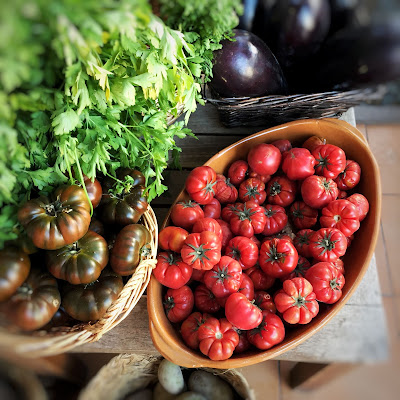


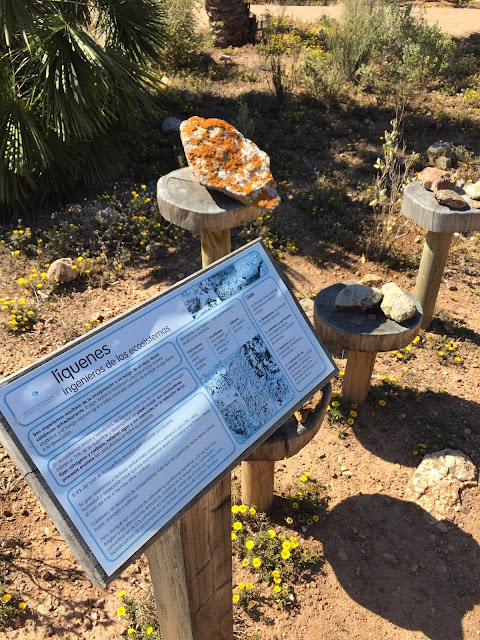
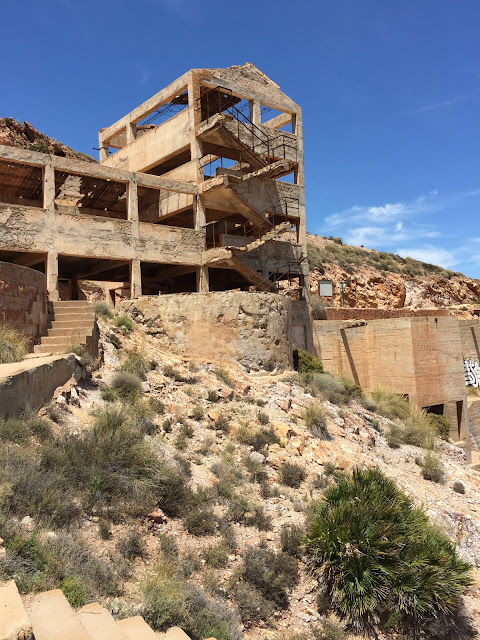
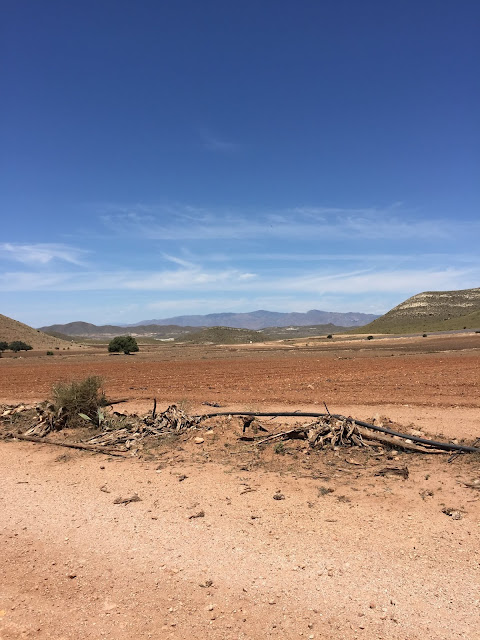

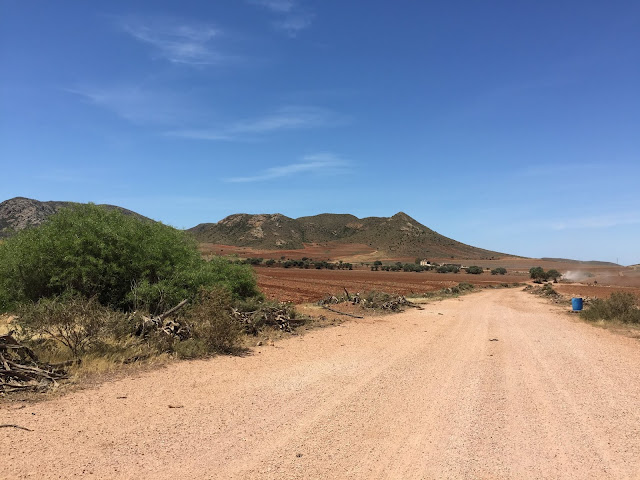










Comments
Post a Comment